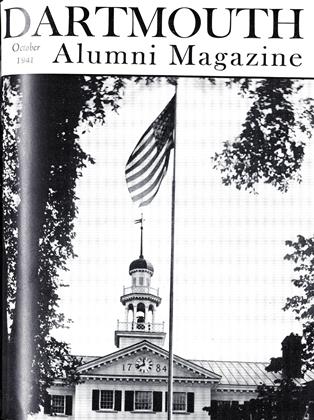WITH THE APPROVAL of the Alumni Council, and the support of the classes concerned, a plan of holding reunions after Commencement was tried in June. The four youngest reuning classes— 1921, 1926, 1931, and 1936—postponed their festivities from the customary Commencement dates to one week later. The change resulted in solving the problem of extreme over-crowding of dormitories and other facilities of the town during Commencement. It also resulted in large attendance and cordial approval of the new plan among the four classes.
The class of '21 enjoyed the change so much that Pres. Bill Embree '21 requested the College to give its blessing to the desire of the class to hold its Twenty Fifth (in 1946, still five years away) on the later week-end. This stalwart group definitely wants to remain listed among the "younger classes."
The Fifteenth Reunion of the class of '26 was attended by so many wives that John St. Clair '26 proposed a "Chintz Plan" for reunions. Under that system, as the members of the class get older and feebler, only the wives will return for reunions, leaving their husbands at home with a pound of tobacco and old copies of the ALUMNI MAGAZINE to while away the hours until the girls get back from Hanover.
The classes of 1931 and 1936 set records for attendance and have only one grievance, in common with the other late reunion classes. A master mind, whose identity is known but will not be revealed by Parkhurst Hall, discovered that reunion tents would collapse by loosening only two ropes. With the aid of an accomplice, whose identity is also an open secret, each tent was "folded" about the time dawn was creeping over Balch Hill, which served to break up the reunion programs that were running a little late.
 View Full Issue
View Full Issue
More From This Issue
-
 Article
ArticleDartmouth Again Faces A World Crisis
October 1941 By WM. STUART MESSER -
 Article
ArticleFavorable Financial Year
October 1941 By Alumni Fund and Over Two Millions Added to Assets -
 Article
ArticleCollege Opens With Convocation Address
October 1941 -
 Class Notes
Class Notes1917*
October 1941 By EUGENE D. TOWLER, DONALD BROOKS -
 Class Notes
Class Notes1912*
October 1941 By CONRAD E. SNOW, RICHARD C. PLUMER -
 Article
ArticleOut-Of-Doors Disciple
October 1941 By ROSS McKENNEY
The Editor
-
 Article
ArticleThe Opening Address
October 1935 By The Editor -
 Article
ArticleCan Pacifists Be Wrong?
November 1935 By The Editor -
 Article
ArticleGradus Ad Parnassum
December 1937 By The Editor -
 Article
ArticleMore Fun at Home
February 1940 By The Editor -
 Article
ArticlePurpose of the College
June 1940 By The Editor -
 Article
ArticleWar Instruction
April 1942 By The Editor
Article
-
 Article
ArticleAt this writing the fiscal year of Dartmouth College is drawing to a close.
July 1918 -
 Article
ArticleAdopt New Schedule
April 1943 -
 Article
ArticleTake a Seat
May/June 2011 -
 Article
ArticleThe Cambridge Nemesis
June 1979 By BRAD HILLS '65 -
 Article
ArticleA Humane Historian
November 1939 By FRANCIS BROWN '25 -
 Article
ArticleWah-Hoo-Wah!
October 1941 By The Editor

